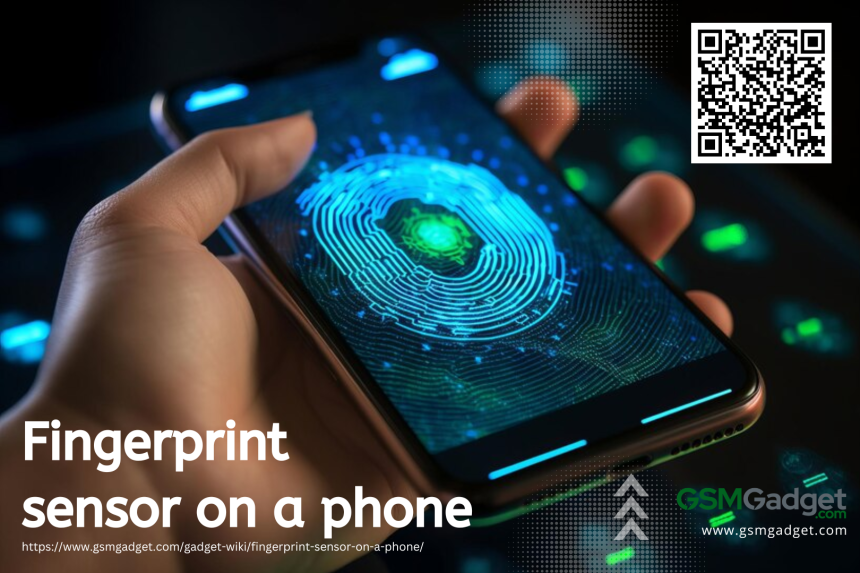A fingerprint sensor on your phone is a key part of keeping it safe. It checks who you are by the unique marks on your finger. You might find it under the screen, on the back, or in the home button. It uses special tech to read the lines and bumps of your fingerprint and turn them into a digital form. Then, the phone’s brain matches this with the fingerprints it already knows. This feature lets you get into your phone fast and keeps your personal stuff safe. It’s a handy and strong way to protect your info, and it’s better than old-school passwords or patterns.
History of Fingerprint Sensors on a phone
Fingerprint sensors in mobile phones have changed how we keep our devices safe. This tech started in the early 2000s. Toshiba’s G500 and G900 phones were some of the first with it in 2007. But Motorola’s Atrix in 2011 made fingerprint readers more popular. Then, Apple put Touch ID on the iPhone 5S in 2013, and everyone started using this feature. Now, we’ve gone from simple swipe sensors to really good ones that use capacitive, optical, and ultrasonic tech. These improvements have made biometrics more accurate and easy to use. Today, fingerprint sensors are a must-have for phone security.
Types of Fingerprint Sensors on a phone
Fingerprint sensors are now a common feature in smartphones, giving us both security and ease of use. They use various technologies to read and identify the unique lines of our fingerprints. Let’s check out the different kinds of fingerprint sensors you can find in phones today.
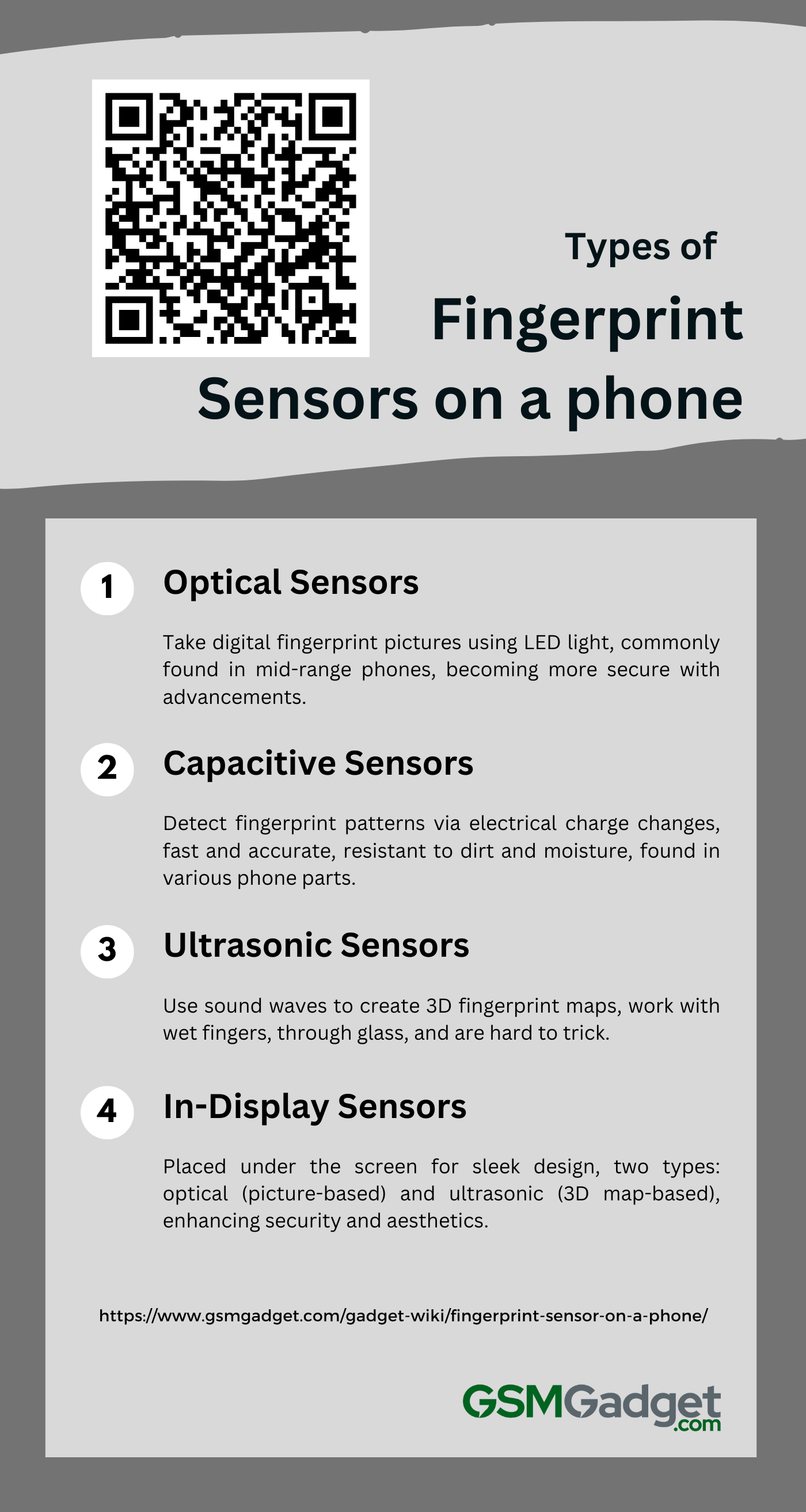
1. Optical Sensors
Optical fingerprint sensors are popular in smartphones for better security. They were one of the first types used in phones. These sensors take a digital picture of your fingerprint. When you put your finger on the sensor, light from LEDs shines on it. The sensor then captures how this light bounces off the unique lines and dips of your fingerprint. A camera or sensor, under the screen or on the back of the phone, records this image. Next, the phone checks this image against the saved fingerprint to confirm who you are. Optical sensors are tough, cost-effective, and often found in mid-range phones. In the past, they weren’t seen as secure as other tech like ultrasonic sensors because people could trick them with a good fake fingerprint. But now, new improvements are making them more accurate and safe.
2. Capacitive Sensors
Capacitive fingerprint sensors are a key security feature in modern smartphones. They use tiny circuits to read the unique patterns of your fingerprint. When you put your finger on the sensor, it can tell the difference between the raised parts and the dips in your finger. This is because the raised parts touch conductive plates and change the electrical charge, while the dips don’t. The sensor then turns this pattern of charges into a digital signal. It compares this signal with the fingerprint data it has saved. These sensors are known for being fast and accurate. They also work well even if there’s dirt or moisture. You can find them in different parts of the phone, like the home button, the back, or under the screen. They make phones safer and are hard to trick with fake fingerprints.
3. Ultrasonic Sensors
Ultrasonic fingerprint sensors are a high-tech way to keep smartphones safe. They use sound waves to make a detailed 3D map of a fingerprint’s tiny lines and holes. Unlike other sensors, they can read fingerprints even if there’s water or oil on your finger. They can also work through glass or screen protectors. Because they create a 3D image, it’s harder for fake prints to trick them. They cost more and are usually found in expensive phones, but their fast and precise readings appeal to people who want strong security.
4. In-Display Fingerprint Sensors
In-Display Fingerprint Sensors on smartphones are a cool mix of function and style. They’re tucked right under the screen, making phones look sleek and easy to use. When you touch the screen, it reads your fingerprint to unlock your phone. There are two types: optical and ultrasonic. Optical sensors snap a picture of your finger, and ultrasonic ones bounce sound waves off your finger to get a 3D map. This tech makes phones look better because there’s no need for an extra button, and it gives you more space to touch and unlock your phone. As phones get slimmer with fewer buttons, these sensors are popping up more. Optical sensors are common and don’t cost much, while ultrasonic sensors work better, even if your fingers are wet or greasy. They’re a big step forward in keeping our phones safe.
Applications of Fingerprint Sensors on a phone
Fingerprint sensors on smartphones are now everywhere. They make things safer and easier for us. With these sensors, we can unlock our phones fast, keep our transactions secure, and get into different apps with just our touch. Let’s look at some main uses of fingerprint sensors in today’s cell phones:
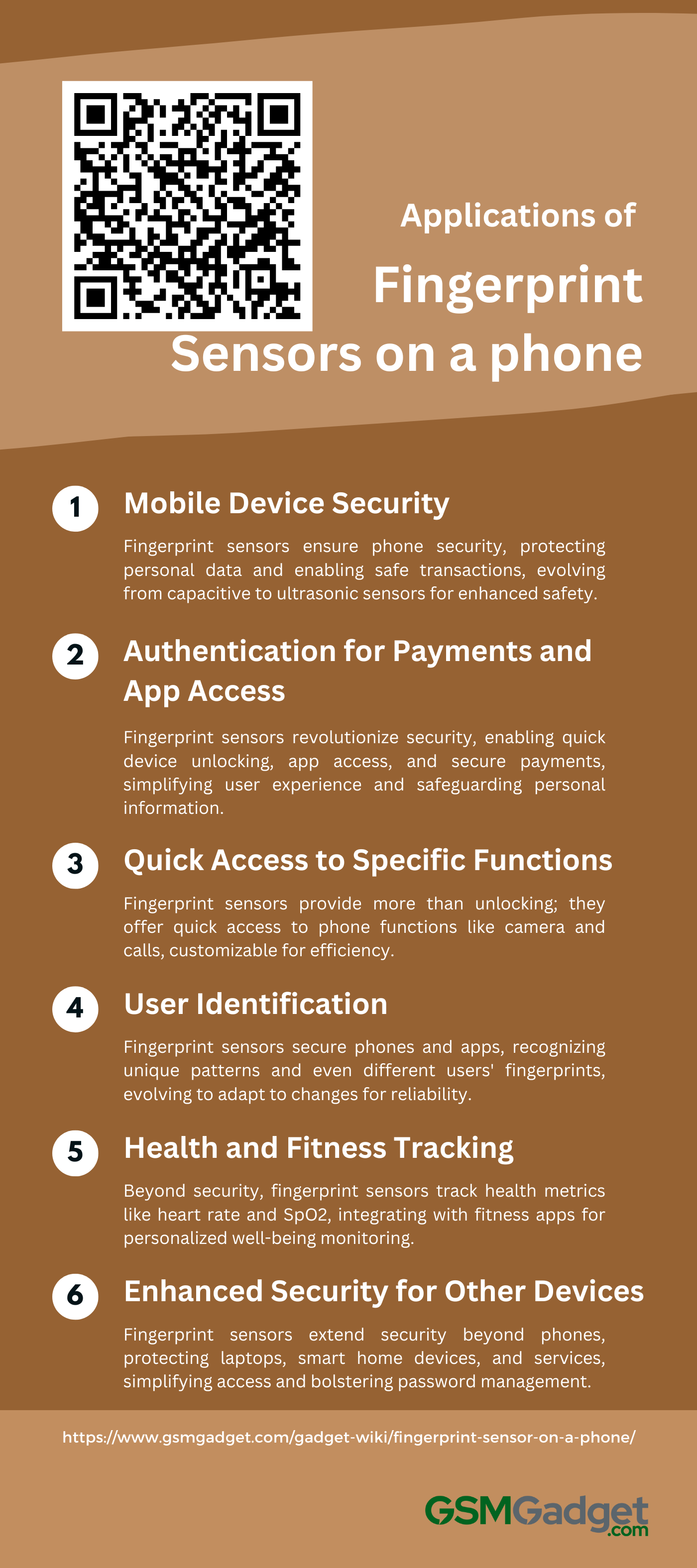
1. Mobile Device Security
Fingerprint sensors are now key for smartphone security. They offer a fast and safe way for users to keep their personal info from falling into the wrong hands. These sensors use the unique marks on your fingertip to make sure only you can unlock your phone, approve payments, and open apps. This is super important as our phones carry sensitive stuff like bank details and private messages. Fingerprint tech has grown to include different types like capacitive, optical, and ultrasonic sensors. This growth means safer mobile payments and less need for easy-to-hack passwords. As these sensors get better, they’re not just making things more convenient; they’re also ramping up security on our phones, giving us peace of mind in our online lives.
2. Authentication for Payments and App Access
Fingerprint sensors on phones have changed how we handle security and ease of use. They are key for unlocking our devices and proving who we are for different apps. These sensors let us pay with our phones, taking the place of passwords or PINs. They make buying things quick and safe by checking our unique fingerprints. This tech is also used to keep apps like banking or messaging secure. Instead of remembering lots of passwords, your fingerprint acts as a personal key. It makes using our devices simpler and keeps our personal and financial info safe. As this technology gets better, we’ll see even more uses for fingerprint sensors, making them a bigger part of our everyday digital lives on phones and other gadgets.
3. Quick Access to Specific Functions
Fingerprint sensors on phones do more than just unlock your device now. They make using your phone smooth by letting you quickly do things with a simple touch. You can use them to start the camera, answer calls, or open apps right away. Plus, you can set them up to know different fingers for different jobs—like using your thumb to check messages and your index finger to play music. This customization saves time and makes using your device easier. It shows how far we’ve come in making these sensors part of our gadgets. They fit neatly into screens but are still strong tools that make our tech life more convenient and efficient.
4. User Identification
Fingerprint sensors on phones are now more than just for unlocking. They’re key for keeping your device and apps like banking safe. They use the unique patterns of your fingerprint to make sure only you can get in. You can even set them up to recognize different fingers or people you trust. Plus, they keep getting smarter, learning any changes in your fingerprints to stay reliable. This tech has made our phones much safer and easier to use, making it a must-have in today’s digital world.
5. Health and Fitness Tracking
Smartphone fingerprint sensors have come a long way. They’re not just for security anymore. Now, they help track health and fitness too. These sensors check your heart rate and blood oxygen levels (SpO2) without any fuss. Just by touching your phone, you can keep your health info private and get tips that are just for you. You can also log your workouts and health stats in fitness apps. This gives you a full picture of how you’re doing with your exercise and heart health over time. It’s pretty cool how our phones have turned into helpers for our well-being, keeping us connected and looking after our health.
6. Enhanced Security for Other Devices
Fingerprint sensors on phones are now key for keeping lots of devices and services safe. They do more than just unlock phones. Now, they protect laptops, tablets, smart home gadgets, and more. They give us one easy way to get into our stuff and cut down the chance of someone else getting in. These sensors also change how we manage passwords. They keep password managers safe, let us do things fast with a finger tap, and add extra security to mobile payments and banking. As smart homes get better, these sensors might control who can change settings at home. Adding fingerprint sensors to phones is a big step. It makes using our digital world safer and easier.
Advantages Fingerprint Sensors on a phone
Fingerprint sensors have changed the way we secure our smartphones, mixing ease with high-tech features. These biometric wonders not only make our phones easier to use but also give them strong protection. Let’s look at the main benefits of having a fingerprint sensor on your phone:
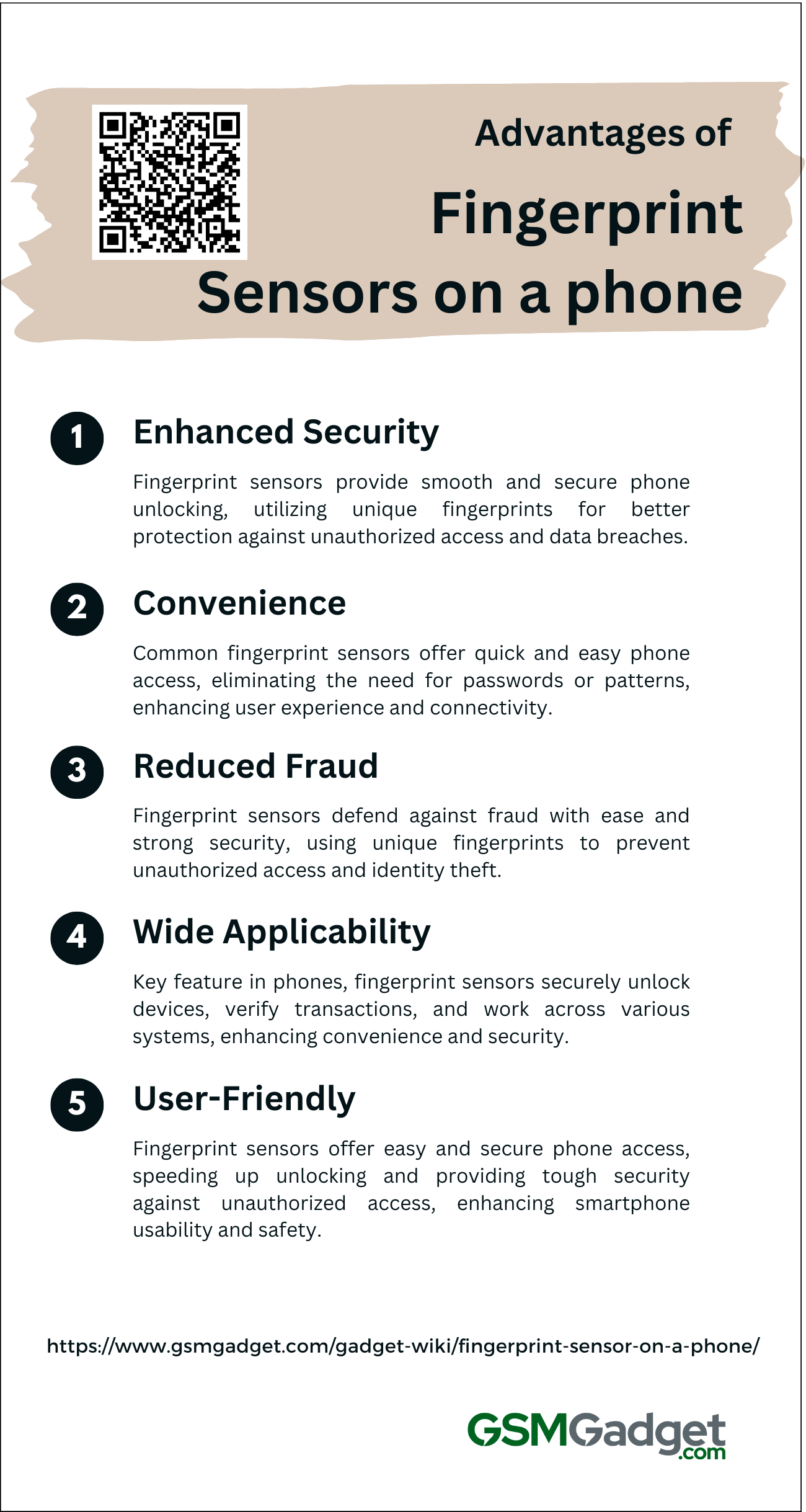
1. Enhanced Security
Fingerprint sensors on phones make unlocking them smooth and safe. They use your fingerprint’s unique design to keep out anyone who shouldn’t get in. This is better than the old passcodes or patterns. Just tapping your finger makes it easy to follow good security habits. It also keeps things like money transfers and private chats safe. Now that these sensors are everywhere in new phones, they give us comfort. They know who the real owner is and stop others from seeing your info, using your payment apps, or getting into important apps. This is a big step up in keeping our smartphones secure.
2. Convenience
Fingerprint sensors on phones are now common for making things easier and safer. They use the one-of-a-kind patterns on our fingertips to quickly unlock our devices. This means we don’t have to remember passwords or patterns. This tech makes getting into our personal stuff and apps a breeze, just with a touch. It speeds up checking who we are for buying things and logging into apps. It’s super handy for people who are always on their phones, keeping them connected without a break. Fingerprint sensors mix speed and safety in a way that fits perfectly with our busy lives today.
3. Reduced Fraud
Fingerprint sensors on phones are a key defense against fraud. They mix ease with strong security. These sensors use your unique fingerprint to make sure only you can unlock your phone and get to private info. This is super important for stopping unauthorized access and fake activities. Since fingerprints are almost impossible to copy, they help prevent identity theft. This feature is really important now that we use our phones for money stuff and keeping personal data. Fingerprint sensors make it easier and safer to use banking and payment apps. They improve how we use our phones and keep us secure, making them a must-have in today’s mobile devices.
4. Wide Applicability
Fingerprint sensors on phones are now a key feature. They offer a safe and easy way to unlock your phone and do more. These sensors quickly check your identity for transactions and apps, working with different systems and devices. They make things better by letting you set shortcuts, like opening the camera fast or calling someone special. They can confirm mobile payments, protect apps and files, and might even take the place of passwords. As this tech gets better, fingerprint sensors will become even more important for keeping our phones secure and easy to use.
5. User-Friendly
Fingerprint sensors on smartphones are a big win for easy security. They let you get into your phone fast, with just a touch—no more PINs or patterns. This tech speeds up unlocking and makes things safer by using your unique fingerprint to keep out unwanted visitors. Plus, it’s great for quick payments and logging into apps without losing any security. Since fingerprints are hard to copy, these sensors add a tough layer of protection. They make phones smarter and safer, which is just what people who love tech want. That’s why fingerprint sensors have become a must-have in our mobile world today.
Challenges and Limitations Fingerprint Sensors on a phone
Fingerprint sensors are now common in smartphones, giving us both ease and safety. But even though they’re popular, these biometric tools have their problems. We’ll look at the main issues, like how accurate sensors are and how things like weather can impact how well they work.
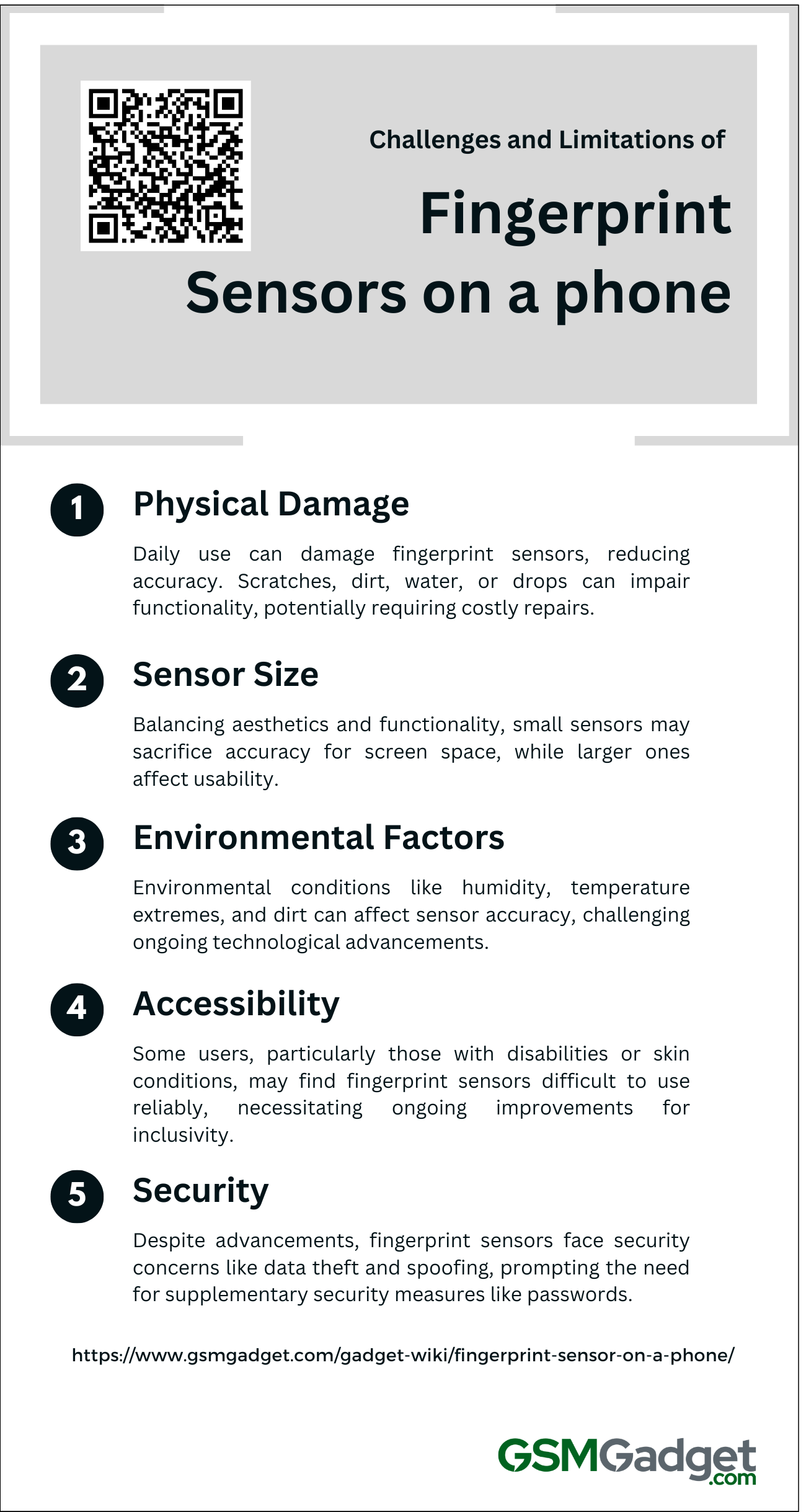
1. Physical Damage
Fingerprint sensors are key for keeping modern smartphones safe. They let us unlock our phones quickly and easily. But, they can get damaged with daily use. Scratches or marks on the sensor can make it less sensitive and accurate. Dust, dirt, and water can also cause problems, leading to wrong readings or even total failure. If you drop your phone or put too much pressure on it, the sensor might get seriously damaged and not work at all. Phone makers are trying to make these sensors stronger with special coatings and tougher materials. Still, damage can happen, and fixing or replacing the sensor can be costly. So, it’s important to be careful with your phone to keep this important security feature working well.
2. Sensor Size
In the world of smartphone security, the size of fingerprint sensors matters a lot. Phone makers work hard to balance size for good looks and screen space without losing strong security. Small sensors look great and give you more screen, but they might not read your fingerprint well, leading to errors. Bigger sensors are better at reading your print but can make the phone less nice to use. The goal is to make sensors that you don’t notice but still work great, keeping your phone safe. As technology gets better, the race to make the perfect hidden sensor that works every time continues.
3. Environmental Factors
Smartphone fingerprint sensors mix ease with security. However, they face issues from the environment that can mess up their accuracy. Wetness from humidity or damp fingers might stop them from getting a good fingerprint, causing mistakes or failures. Extreme cold can slow down recognition, and heat can make sweaty or oily fingers worse. Dust and dirt can cover the sensor and lead to errors. Even things like cuts on fingers or rough skin can cause problems. Companies are working hard to make sensors better. They’re adding new tech like pulse and heat checks to make sure the fingerprint is real. But even with these improvements, environmental challenges still push the limits of phone biometric tech. This means there’s always more work to do to overcome these issues.
4. Accessibility
Fingerprint sensors on phones are handy for keeping your device secure. However, they can be hard to use for some people. Folks with disabilities or skin issues like dermatitis might find these sensors tough to work with. Also, wetness or very dry conditions can mess up their accuracy. If you do a lot of manual work, it can make the sensor less sensitive over time. Plus, if you have small hands or find it tricky to reach back-mounted sensors, it could be a problem. As this tech gets better, it’s important for companies to fix these issues. That way, fingerprint sensors will be good for everyone and keep our phones safe and easy to use.
5. Security
Fingerprint sensors on phones are handy and high-tech, but they have their security issues. One big worry is that if a hacker gets your fingerprint data, they could unlock your phone. Also, these sensors can be tricked by fake fingerprints or even clear pictures of one. Sometimes, the sensor might wrongly think an unapproved fingerprint is okay, which is a problem. Plus, people with rough or damaged fingerprints might not always get recognized, causing lockouts. So, while fingerprint sensors are a cool security feature, it’s best to use them with other methods like PINs, passwords, or two-factor authentication for better safety.
